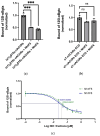Neutralizing Nanobodies against Venoms from Naja haje Species Captured in North Africa
- PMID: 39330851
- PMCID: PMC11435604
- DOI: 10.3390/toxins16090393
Neutralizing Nanobodies against Venoms from Naja haje Species Captured in North Africa
Abstract
Snakebite envenoming (SBE) remains a severely neglected public health issue, particularly affecting tropical and subtropical regions, with Africa experiencing an estimated 435,000 to 580,000 snakebites annually, leading to high morbidity and mortality rates, especially across Africa and Asia. Recognized as a Neglected Tropical Disease, SBE management is further complicated by the inadequate efficacy of current antivenom treatments. Of particular concern are cobras (Naja sp.), whose neurotoxins can induce rapid fatal respiratory paralysis. In this study, we investigate the potential of nanobodies as a promising next-generation of immunotherapeutics against cobra venoms. Through a dual strategy of the characterization of venom toxic fractions from cobras captured for the first time in Algeria and Tunisia biotopes, coupled with in vitro assays to evaluate their interactions with acetylcholine receptors, and subsequent immunization of dromedaries to produce specific nanobodies, we identified two lethal fractions, F5 and F6, from each venom, and selected five nanobodies with significant binding and neutralizing of 3DL50 (0.74 mg/kg). The combination of these nanobodies demonstrated a synergistic effect, reaching 100% neutralizing efficacy of 2DL50 lethal venom fraction (0.88 mg/kg) doses in mice. Additionally, our findings highlighted the complex mechanism of cobra venom action through the lethal synergism among its major toxins.
Keywords: LD50; Naja haje; cobra venom; nanobody; neutralizing capacity.
Conflict of interest statement
The authors declare no conflicts of interest.
Figures







Similar articles
-
Phage display-derived alpaca nanobodies as potential therapeutics for Naja atra snake envenomation.Appl Environ Microbiol. 2024 Aug 21;90(8):e0012124. doi: 10.1128/aem.00121-24. Epub 2024 Jul 9. Appl Environ Microbiol. 2024. PMID: 38980046 Free PMC article.
-
Development and characterization of nanobody against envenomation by Naja naja oxiana.Toxicon. 2024 Oct;249:108057. doi: 10.1016/j.toxicon.2024.108057. Epub 2024 Aug 3. Toxicon. 2024. PMID: 39103096
-
A Neurotoxic Snake Venom without Phospholipase A2: Proteomics and Cross-Neutralization of the Venom from Senegalese Cobra, Naja senegalensis (Subgenus: Uraeus).Toxins (Basel). 2021 Jan 14;13(1):60. doi: 10.3390/toxins13010060. Toxins (Basel). 2021. PMID: 33466660 Free PMC article.
-
A Review of the Proteomic Profiling of African Viperidae and Elapidae Snake Venoms and Their Antivenom Neutralisation.Toxins (Basel). 2022 Oct 22;14(11):723. doi: 10.3390/toxins14110723. Toxins (Basel). 2022. PMID: 36355973 Free PMC article. Review.
-
A Quest for a Universal Plasma-Derived Antivenom Against All Elapid Neurotoxic Snake Venoms.Front Immunol. 2021 Apr 23;12:668328. doi: 10.3389/fimmu.2021.668328. eCollection 2021. Front Immunol. 2021. PMID: 33968072 Free PMC article. Review.
References
-
- WHO Snakebite: WHO Targets 50% Reduction in Deaths and Disabilities. [(accessed on 22 July 2024)]. Available online: https://www.who.int/news/item/06-05-2019-snakebite-who-targets-50-reduct....
-
- Williams D.J., Faiz M.A., Abela-Ridder B., Ainsworth S., Bulfone T.C., Nickerson A.D., Habib A.G., Junghanss T., Fan H.W., Turner M., et al. Strategy for a globally coordinated response to a priority neglected tropical disease: Snakebite envenoming. PLoS Neglected Trop. Dis. 2019;13:e0007059. doi: 10.1371/journal.pntd.0007059. - DOI - PMC - PubMed
-
- Chippaux J.-P., White J., Habib A.G. African Snakes. In: Brent J., Burkhart K., Dargan P., Hatten B., Megarbane B., Palmer R., White J., editors. Critical Care Toxicology: Diagnosis and Management of the Critically Poisoned Patient. Springer International Publishing; Cham, Switzerland: 2017. pp. 2319–2342.
-
- Sánchez A., Segura Á., Pla D., Munuera J., Villalta M., Quesada-Bernat S., Chavarría D., Herrera M., Gutiérrez J.M., León G., et al. Comparative venomics and preclinical efficacy evaluation of a monospecific Hemachatus antivenom towards sub-Saharan Africa cobra venoms. J. Proteom. 2021;240:104196. doi: 10.1016/j.jprot.2021.104196. - DOI - PubMed
Publication types
MeSH terms
Substances
Grants and funding
LinkOut - more resources
Full Text Sources
Miscellaneous

